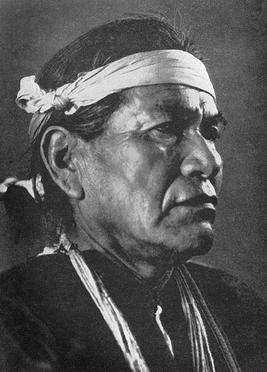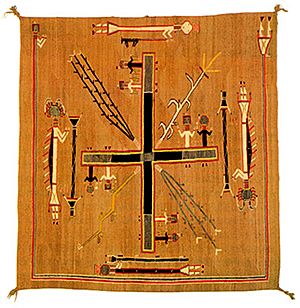Hosteen Klah facts for kids
Quick facts for kids
Hosteen Klah
|
|
|---|---|

Hosteen Klah in middle age.
|
|
| Born |
1867 Bear Mountain, near Fort Wingate, New Mexico
|
| Died | February 27, 1937 |
| Nationality | American / Navajo |
| Known for | Weaver, artist and medicine man (chanting and sandpainting) |
| Movement | Founded the Wheelwright Museum of the American Indian with Mary Cabot Wheelwright |
Hosteen Klah (born Hastiin Tłʼa, 1867–1937) was an important Navajo artist and a respected medicine man. He helped record important parts of Navajo religion and their special ceremonies. He was known as a nádleehi person. This meant he took on roles usually done by both men and women. He was a skilled ceremonial singer and a master weaver.
Contents
Early Life and Training
Hosteen Klah was born in 1867 in New Mexico, USA. His Navajo parents were Hoksay Nolyae and Ahson Tsosie. He was called 'Klah' because he was left-handed. Klah did not attend residential schools. Instead, he learned traditional Navajo spiritual ways from his uncle. His uncle was a medicine man.
Klah was trained in healing ceremonies. These ceremonies included dancing, chanting, singing, and sandpainting. Sandpainting is creating temporary designs on the ground. These designs are made using colored dirt and shells. Klah was very talented. He could fully remember and perform his first ceremony by the age of ten.
Understanding Gender Roles
Hosteen Klah was identified as a Nádleeh (plural Nádleehi). This Navajo term means "one-who-has-been-changed." Nádleehi are a third gender recognized by the Navajo people. They take on roles that are traditionally for both men and women. For Klah, this meant being a healer (a male role) and a weaver (a female role). At that time, Nádleehi, including Klah, were often assigned male at birth.
Master Weaver and Artist
Klah became skilled in many traditional art forms. His most famous works were sandpainting and weaving. He learned weaving from his mother. Klah wove his first complete weaving in 1892. This was at the World's Columbian Exposition in Chicago. He likely also showed sandpainting there.
Around 1914, Klah started trying new things. He began to combine sacred images with weaving. He wove images from the Yéʼii bicheii dance into a rug. He finished his first weaving inspired by sandpainting around 1919. Some other healers in his community found these weavings unusual. Sandpaintings made during ceremonies are meant to be temporary. Klah made them permanent by weaving them. His colorful and detailed designs were very popular. Many art collectors bought his work.
In 1934, Klah showed sandpainting again. This was at the Century of Progress Exhibition in Chicago. President Franklin D. Roosevelt was there to see it. Klah taught his two nieces his weaving skills and designs. He passed away in 1937.
Founding the Wheelwright Museum
In 1921, Hosteen Klah met Mary Cabot Wheelwright. She was from a wealthy family in Boston. They became good friends. Together, they founded the Wheelwright Museum of the American Indian. This museum is in Santa Fe, New Mexico.
Klah was worried about the future of Navajo religion. He had seen many years of efforts by missionaries and the US government to change traditional culture. He wanted to record Navajo religion. He hoped it would be saved for future generations. The museum was first called the Navajo House of Prayer. Then it was named the Museum of Navajo Ceremonial Art. In 1977, it was renamed the Wheelwright Museum.
In 1942, the museum published a book. It was called Navajo Creation Myth - the Story of the Emergence. Hosteen Klah told the stories, and Mary C. Wheelwright wrote them down.
Later Life and Legacy
Hosteen Klah died on February 27, 1937. He passed away from pneumonia. He is buried on the grounds of the Wheelwright Museum. His work helped preserve important parts of Navajo culture and art.
See also


